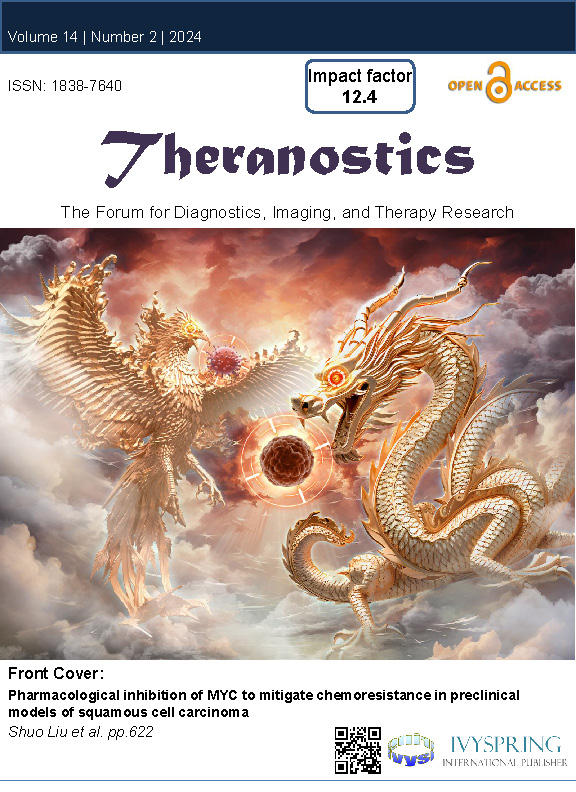肿瘤胎儿 TRIM71 通过重塑 CEBPA 介导的丝氨酸/甘氨酸代谢驱动肝癌发生
IF 12.4
1区 医学
Q1 MEDICINE, RESEARCH & EXPERIMENTAL
引用次数: 0
摘要
理论依据:肿瘤细胞重塑转录组,构建具有干性特征的生态系统,从而维持肿瘤的生长和高度恶性特征。然而,参与这一过程的核心调控因子仍有待进一步发现:收集来自胎儿肝脏、正常肝脏、肝脏肿瘤及其邻近样本的单细胞RNA-sequncing(scRNA-seq)和大量RNA测序图谱,分析肝癌的生态系统。建立了小鼠模型,利用尾静脉流体动力注射鉴定胎儿相关癌基因的分子功能:我们发现肝癌重建了胎盘生态系统以维持恶性特征。有趣的是,我们发现了一组RNA结合蛋白(RBPs),这些蛋白的高表达与胎盘特征有关。其中,TRIM71在肝癌中特异性表达,并与不良预后相关。TRIM71驱动肝细胞癌(HCC)的发生,敲除TRIM71可显著抑制肝癌细胞的增殖。从机理上讲,TRIM71与IGF2BP1形成蛋白复合物,以m6A依赖的方式与CEBPA的mRNA结合并稳定其mRNA,增强丝氨酸/甘氨酸代谢途径,最终促进肝癌的进展。此外,我们还发现全反式维甲酸(ATRA)与 e1A 结合蛋白 p300(EP300)抑制剂 A-485 联合使用可抑制 TRIM71,减弱甘氨酸/丝氨酸代谢,抑制 TRIM71 水平较高的肝癌细胞增殖:我们证明了肝癌中的胎盘状态,强调了 TRIM71 的关键作用,并为肝癌患者提供了潜在的治疗策略和肝癌特异性生物标记物。本文章由计算机程序翻译,如有差异,请以英文原文为准。
Oncofetal TRIM71 drives liver cancer carcinogenesis through remodeling CEBPA-mediated serine/glycine metabolism
Rationale: Tumor cells remodel transcriptome to construct an ecosystem with stemness features, which maintains tumor growth and highly malignant characteristics. However, the core regulatory factors involved in this process still need to be further discovered./nMethods: Single cell RNA-sequncing (scRNA-seq) and bulk RNA-sequencing profiles derived from fetal liver, normal liver, liver tumors, and their adjacent samples were collected to analyze the ecosystem of liver cancer. Mouse models were established to identify molecular functions of oncofetal-related oncogenes using hydrodynamic tail vein injection./nResults: We found that liver cancer rebuilt oncofetal ecosystem to maintain malignant features. Interestingly, we identified a group of RNA-binding proteins (RBPs) that were highly overexpressed with oncofetal features. Among them, TRIM71 was specifically expressed in liver cancers and was associated with poor outcomes. TRIM71 drove the carcinogenesis of hepatocellular carcinoma (HCC), and knockdown of TRIM71 significantly abolished liver cancer cell proliferation. Mechanistically, TRIM71 formed a protein complex with IGF2BP1, bound to and stabilized the mRNA of CEBPA in an m6A-dependent manner, enhance the serine/glycine metabolic pathway, and ultimately promoted liver cancer progression. Furthermore, we identified that all-trans-retinoic acid (ATRA) combined with e1A binding protein p300 (EP300) inhibitor A-485 repressed TRIM71, attenuated glycine/serine metabolism, and inhibited liver cancer cell proliferation with high TRIM71 levels./nConclusions: We demonstrated the oncofetal status in liver cancer and highlighted the crucial role of TRIM71 and provided potential therapeutic strategies and liver cancer-specific biomarker for liver cancer patients.
求助全文
通过发布文献求助,成功后即可免费获取论文全文。
去求助
来源期刊

Theranostics
MEDICINE, RESEARCH & EXPERIMENTAL-
CiteScore
25.40
自引率
1.60%
发文量
433
审稿时长
1 months
期刊介绍:
Theranostics serves as a pivotal platform for the exchange of clinical and scientific insights within the diagnostic and therapeutic molecular and nanomedicine community, along with allied professions engaged in integrating molecular imaging and therapy. As a multidisciplinary journal, Theranostics showcases innovative research articles spanning fields such as in vitro diagnostics and prognostics, in vivo molecular imaging, molecular therapeutics, image-guided therapy, biosensor technology, nanobiosensors, bioelectronics, system biology, translational medicine, point-of-care applications, and personalized medicine. Encouraging a broad spectrum of biomedical research with potential theranostic applications, the journal rigorously peer-reviews primary research, alongside publishing reviews, news, and commentary that aim to bridge the gap between the laboratory, clinic, and biotechnology industries.
 求助内容:
求助内容: 应助结果提醒方式:
应助结果提醒方式:


